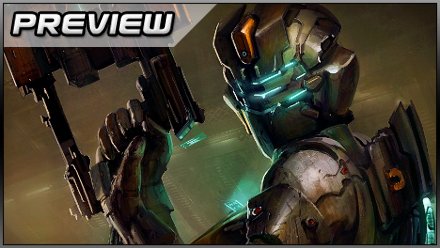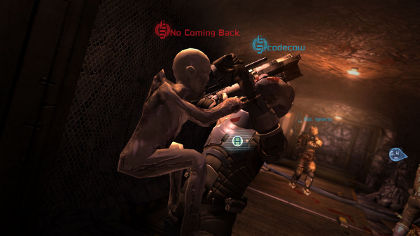
Did you expect Dead Space 2 to sport an online component? Because I didn’t. Adding multiplayer to a chart-proven solo game makes good commercial sense, granted, but the original’s lumbering pace and penchant for close confines aren’t qualities one tends to associate with the upper crust of Xbox Live and PlayStation Network. Killzone 2 was picked on for its slightly stodgy controls, remember, and Dead Space makes Killzone 2 feel like WipEout HD.
Less surprising is the revelation that the sequel’s online offerings bear a strong resemblance to Left 4 Dead. There aren’t that many acts to follow in the multiplayer-oriented survival horror genre, after all (indie connoisseurs: feel free to weigh in with your Recommended lists), and of those acts, Valve’s Romero-flavoured take on Gauntlet is the one that turns heads.
Can Visceral take things up a level? We didn’t press Art Director Ian Milham on the subject when we interviewed him last week, suspecting that he’d flinch at the prospect of comparison headlines and clam up, but the thought loomed large in our minds during the playtest, like a necrotic elephant in a single-seater escape capsule.
Dead Space 2′s online modes are all team-oriented, all asymmetrical, with no vanilla free-for-all option and no same-species slaughter. Four human engineers must fulfil objectives like retrieving bomb parts or activating computer terminals, and four Necromorphs (aka Space Zombies) must get in the way. Cue showers of organs, dark corners and many cries of “hey, it’s kind of like that bit in the Parish when – OH GOD, MY LEG, MY LEG.”
Being the slowest, least agile and least sensitive of the lifeforms in play, the engineers are best off in a tight group, laser sights pointing in all directions. They have the fewest options when respawning – on the two maps we played, Titan Mines and Solar Array, there was only one human spawn point – and take the longest to do so, a startlingly crucial five to 10 seconds.
Plasma Cutters and assault rifles give human players the edge at a distance, but their stasis modules may also carry the day at proximity, pitching attackers into walking-underwater mode. Telekinesis gets an airing too, though its offensive potential is mixed. We had a crack at picking up chopped Necro arms and stapling their owners to walls with them, but the fiddliness of the operation didn’t do much for our death: kill ratio. Jedi mind tricks are best saved for out-of-reach ammo clips and health packs.
If you’re more of a sadist than a survivor, you’re obviously going to be more interested in the mutants. Springing from air vents all around the map, Necromorph will gang up on stragglers, exploit blind sides, rain acidic goo on bunched-up squads and generally do their utmost to bog the proceedings in deathmatch. They can spot the twinkle of nerve systems through walls and engage their owners in button-bashy wrestling matches, allowing other Necros to close in.
There are four breeds, rotated at respawn. The Pack are pasty, shrunken horrors who can leap over or scurry under the line of fire; as the fastest to respawn, they’re usually the rank and file. The twisted, infant Lurkers scale walls and ceilings, hurling darts from their tentacles. Pukers, oozy Number 8s with hazardous indigestion, are your shock troops, while the grand-standing Spitters fill in as elites, marrying guillotine arms to high velocity phlegm.
Coordination isn’t quite as important here, given shorter respawn times and the luxury of extra-sensory perception, but a well-drilled engineer squad will soon put paid to a Zerg rush. Even flesh-modifying viral infestations need brains. Lurkers must find a safe vantage point, then soften up, finish off or distract. Pack players should get in people’s faces and stop them thinking about the bigger picture, i.e. Pukers and Spitters.
Everything locks together successfully but messily, with meat-grinder moments ten a penny. It’s clear, even on the strength of four or five matches, that Dead Space 2 isn’t about to rival Valve’s game for polish and nuance. The engine isn’t really built for the level of freeform action Visceral’s asking of it. When scuttling around as a Lurker, there’s a slight tendency to get hung up on door frames or against walk-rails; when hurtling into the fray as Pack, you’ll sometimes miss a platform completely because your toe clipped the edge.
Where Dead Space 2 may outshine its inspirations, though, is on the experience ladder, which we’ve only an inkling of at present. A few radical unlockable Necro abilities and engineer weapons – something in a stealthy vein, for instance – could make the difference between a mincing machine with aspirations and a game where tactics and communication are the point, screechy, lurid carnage the pay-off.
Dead Space 2 is due out on 25th January for Xbox 360, PlayStation 3 and PC. Read our interview with Ian Milham here.






 Satoru Iwata Video Interview - the late Nintendo president spoke with Kikizo in 2004 as 'Nintendo Revolution' loomed.
Satoru Iwata Video Interview - the late Nintendo president spoke with Kikizo in 2004 as 'Nintendo Revolution' loomed. Kaz Hirai Video Interview - the first of Kikizo's interviews with the man who went on to become global head of Sony.
Kaz Hirai Video Interview - the first of Kikizo's interviews with the man who went on to become global head of Sony. Ed Fries Video Interview - one of Xbox's founders discusses an epic journey from Excel to Xbox.
Ed Fries Video Interview - one of Xbox's founders discusses an epic journey from Excel to Xbox. Yu Suzuki, the Kikizo Interview - we spend time with one of gaming's most revered creators.
Yu Suzuki, the Kikizo Interview - we spend time with one of gaming's most revered creators. Tetris - The Making of an Icon: Alexey Pajitnov and Henk Rogers reveal the fascinating story behind Tetris
Tetris - The Making of an Icon: Alexey Pajitnov and Henk Rogers reveal the fascinating story behind Tetris Rare founders, Chris and Tim Stamper - their only interview? Genuinely 'rare' sit down with founders of the legendary studio.
Rare founders, Chris and Tim Stamper - their only interview? Genuinely 'rare' sit down with founders of the legendary studio. The History of First-Person Shooters - a retrospective, from Maze War to Modern Warfare
The History of First-Person Shooters - a retrospective, from Maze War to Modern Warfare